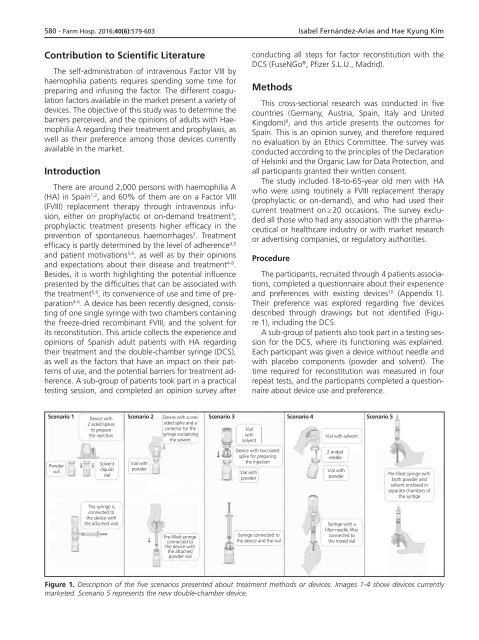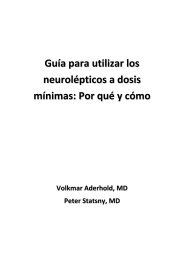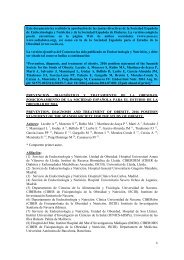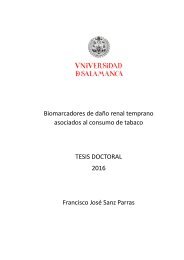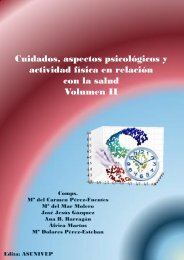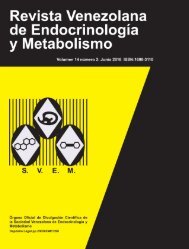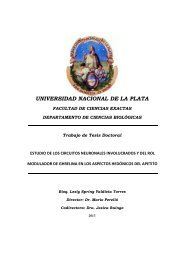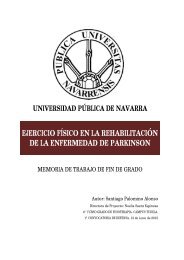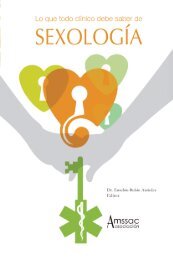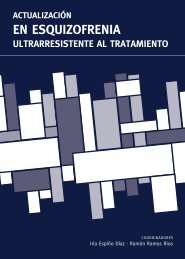Noviembre-Diciembre
156_v40n6(1)
156_v40n6(1)
Create successful ePaper yourself
Turn your PDF publications into a flip-book with our unique Google optimized e-Paper software.
580 - Farm Hosp. 2016;40(6):579-603 Isabel Fernández-Arias and Hae Kyung Kim<br />
Contribution to Scientific Literature<br />
The self-administration of intravenous Factor VIII by<br />
haemophilia patients requires spending some time for<br />
preparing and infusing the factor. The different coagulation<br />
factors available in the market present a variety of<br />
devices. The objective of this study was to determine the<br />
barriers perceived, and the opinions of adults with Haemophilia<br />
A regarding their treatment and prophylaxis, as<br />
well as their preference among those devices currently<br />
available in the market.<br />
Introduction<br />
There are around 2,000 persons with haemophilia A<br />
(HA) in Spain 1,2 , and 60% of them are on a Factor VIII<br />
(FVIII) replacement therapy through intravenous infusion,<br />
either on prophylactic or on-demand treatment 3 ;<br />
prophylactic treatment presents higher efficacy in the<br />
prevention of spontaneous haemorrhages 3 . Treatment<br />
efficacy is partly determined by the level of adherence 4,5<br />
and patient motivations 5,6 , as well as by their opinions<br />
and expectations about their disease and treatment 4-8 .<br />
Besides, it is worth highlighting the potential influence<br />
presented by the difficulties that can be associated with<br />
the treatment 5,8 , its convenience of use and time of preparation<br />
4-6 . A device has been recently designed, consisting<br />
of one single syringe with two chambers containing<br />
the freeze-dried recombinant FVIII, and the solvent for<br />
its reconstitution. This article collects the experience and<br />
opinions of Spanish adult patients with HA regarding<br />
their treatment and the double-chamber syringe (DCS),<br />
as well as the factors that have an impact on their patterns<br />
of use, and the potential barriers for treatment adherence.<br />
A sub-group of patients took part in a practical<br />
testing session, and completed an opinion survey after<br />
conducting all steps for factor reconstitution with the<br />
DCS (FuseNGo ® , Pfizer S.L.U., Madrid).<br />
Methods<br />
This cross-sectional research was conducted in five<br />
countries (Germany, Austria, Spain, Italy and United<br />
Kingdom) 9 , and this article presents the outcomes for<br />
Spain. This is an opinion survey, and therefore required<br />
no evaluation by an Ethics Committee. The survey was<br />
conducted according to the principles of the Declaration<br />
of Helsinki and the Organic Law for Data Protection, and<br />
all participants granted their written consent.<br />
The study included 18-to-65-year old men with HA<br />
who were using routinely a FVIII replacement therapy<br />
(prophylactic or on-demand), and who had used their<br />
current treatment on ≥ 20 occasions. The survey excluded<br />
all those who had any association with the pharmaceutical<br />
or healthcare industry or with market research<br />
or advertising companies, or regulatory authorities.<br />
Procedure<br />
The participants, recruited through 4 patients associations,<br />
completed a questionnaire about their experience<br />
and preferences with existing devices 10 (Appendix 1).<br />
Their preference was explored regarding five devices<br />
described through drawings but not identified (Figure<br />
1), including the DCS.<br />
A sub-group of patients also took part in a testing session<br />
for the DCS, where its functioning was explained.<br />
Each participant was given a device without needle and<br />
with placebo components (powder and solvent). The<br />
time required for reconstitution was measured in four<br />
repeat tests, and the participants completed a questionnaire<br />
about device use and preference.<br />
Scenario 1<br />
Device with<br />
2 sided spikes<br />
to prepare<br />
the injection<br />
Scenario 2 Device with a one Scenario 3 Scenario 4 Scenario 5<br />
sided spike and a<br />
corrector for the<br />
Vial<br />
syringe containing<br />
with<br />
the solvent<br />
solvent<br />
Vial with solvent<br />
Powder<br />
vial<br />
Solvent<br />
(liquid)<br />
vial<br />
Vial with<br />
powder<br />
Device with two-sided<br />
spike for preparing<br />
the injection<br />
Vial with<br />
powder<br />
2 ended<br />
needle<br />
Vial with<br />
powder<br />
Pre-filled syringe with<br />
both powder and<br />
solvent enclosed in<br />
separate chambers of<br />
the syringe<br />
The syringe is<br />
connected to<br />
the device with<br />
the attached vials<br />
Pre-filled syringe<br />
connected to<br />
the device with<br />
the attached<br />
powder vial<br />
Syringe connected to<br />
the device and the vial<br />
Syringe with a<br />
filter needle filter<br />
connected to<br />
the mixed vial<br />
Figure 1. Description of the five scenarios presented about treatment methods or devices. Images 1-4 show devices currently<br />
marketed. Scenario 5 represents the new double-chamber device.


